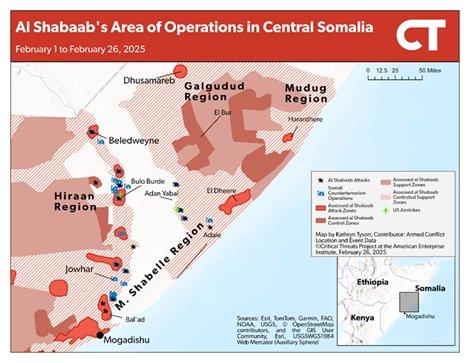Al Shabaab is launching a major offensive across central Somalia as the group attempts to overturn landmark, US-backed Somali counterterrorism gains from 2022.
Al Shabaab launched the largest and most complex attacks since at least April 2024 against Somali National Army (SNA) and Somali clan militia forces in Middle Shabelle, central Somalia, on February 20.[118] The attacks targeted forward operating bases in seven towns in contested areas on opposite sides of Middle Shabelle that Somali forces previously cleared during a counterterrorism offensive in 2022.
The offensive included suicide vehicle-borne improvised explosive devices in at least one of the attacks.[119] The SNA said that it killed 130 al Shabaab fighters, and al Shabaab said that it killed over 90 Somali soldiers during the clashes.[120]
Al Shabaab temporarily seized at least three towns overnight until Somali forces expelled the fighters on February 21.[121] US AFRICOM conducted ”self-defense airstrikes on February 25 targeting one of the towns that al Shabaab attacked on February 20 and 25.[122] Local reports suggest that al Shabaab withdrew from some areas before Somali forces reentered the towns.[123]
Al Shabaab launched another series of multifront attacks on Somali forces in central Somalia on February 25 and 26. Al Shabaab conducted attacks on at least three towns in the Hiraan region, north of Middle Shabelle on February 25.[124] The attacks once again occurred on opposite sides of the region. Al Shabaab temporarily seized Bal’ad, a district capital in Middle Shabelle that lies 15 miles (23 kilometers) from the Mogadishu district limits, on February 26.[125]
The attackers freed al Shabaab prisoners from the local prison before Burundian African Union troops and Somali forces retook the town.[126] The freed prisoners will boost al Shabaab’s manpower and further support the group’s ongoing offensive.
Al Shabaab targeted symbolically and militarily important towns in areas that al Shabaab had long controlled before local clan militias and the Somali Federal Government (SFG) launched the 2022 offensive. Al Shabaab on February 20 attacked a town 18 miles (29 kilometers) away from the district capital Adan Yabal, which was al Shabaab’s regional center of operations in Middle Shabelle from 2016 until 2022.[127]
Al Shabaab attacked El Baraf on the same day, which serves as a transportation hub at the junction of several roads that al Shabaab controlled until 2016.[128] Al Shabaab has not attacked El Baraf since 2022.[129] Al Shabaab contested control in and around Adan Yabal intermittently in 2023 and 2024 but had not launched an attack of this scale or sophistication during this period.[130]
The attacks in eastern Hiraan on February 25 occurred in Bulo Burde district, where al Shabaab first attempted to cross the Shabelle River and reinfiltrate central Somalia in early January.[131]
Al Shabaab may have timed this offensive to coincide with the start of Ramadan on February 28 or to conclude before Somalia’s rainy season begins in April. Al Shabaab and other Salafi-jihadi groups also regularly conduct offensives during Ramadan.[132]
Al Shabaab activity typically decreases during the rainy season, as the terrain becomes difficult to navigate and their ability to control local populations through access to water is reduced.[133]
Figure 7. Al Shabaab’s Area of Operations in Central Somalia
Al Shabaab seeks to overwhelm Somali forces and link its support zones in central Somalia with its core territories in southern Somalia. Al Shabaab already launched an offensive in January 2025 in central Somalia to reestablish itself on the east bank of the Shabelle River north of Middle Shabelle in the Hiraan region.[134]
Expanded al Shabaab support zones in central Somalia that reestablish its presence across Hiraan and Middle Shabelle would strengthen the lines of communication between al Shabaab’s center of gravity in the south and its fighters in central Somalia. [135] Al Shabaab’s expanded presence would allow it to threaten major government-controlled administrative centers and a major highway that runs between Ethiopia and Mogadishu.[136]
Somali forces cleared this highway that connects Mogadishu, central Somalia, and Ethiopia during its offensive in 2022.[137] Control over the road is a major revenue generation opportunity for al Shabaab, clan militias, and the local and federal Somali government given the numerous taxation checkpoints on the road that affect local trade and trucks traveling between the port of Mogadishu and Ethiopia.[138] Al Shabaab failed to secure these objectives in similar offensives in 2023 and 2024.[139]
The withdrawal of Burundian forces from the African Union (AU) mission in Somalia may create further gaps for al Shabaab to exploit in central Somalia. Burundian forces have been deployed in Somalia since 2007 and were based in Middle Shabelle under the former AU mission.[140]
Burundi stated its intention to withdraw from the new AU mission in Somalia days before the mission officially began on January 1, 2025, after the SFG allocated Burundi 1,000 soldiers to the mission, a figure that Burundian officials said was half of what was necessary to ensure adequate force protection.[141]
An unclear number Burundian forces remained in Somalia and have been directly involved in efforts to repel the al Shabaab incursions into central Somalia, however, while the two countries have tried to negotiate a solution.[142]
Burundi and SFG confirmed on February 25 that Burundian forces will not be part of the new mission, and the SFG has not given a timetable for the withdrawal of Burundian forces or indicated how it aims to replace Burundian troops.[143].
Read more: Africa File: February 27, 2025
Source: The Institute for the Study of War


Leave a Reply